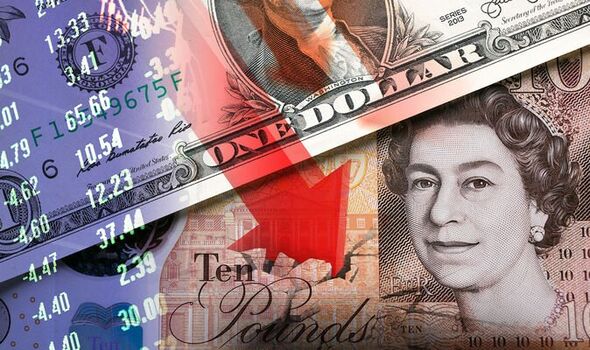LONDON (Reuters) - Sterling fell on Thursday against the U.S. dollar and euro as the Royal Institution of Chartered Surveyors said Britain saw in November the most widespread house price falls since early in the COVID-19 pandemic.
The survey showed demand from buyers and sales activity slowed in the face of higher borrowing costs.
Investors also pondered how interest-rate hike bets by the Bank of England will worsen the recession outlook in Britain.
The Bank of England (BoE) is expected to raise bank rate by 50 basis points to 3.50% next week despite the economy moving towards recession, as it battles inflation running at more than five times its target, a Reuters poll found.
Quarterly forecasts suggest the economy shrank 0.2% last quarter and will contract by 0.4% in this one, meeting the technical definition of recession.
The outlook for next year is just as gloomy, with the economy expected to shrink in the first three quarters of 2023, according to economists polled by Reuters.
The UK is facing a winter of strikes as workers from rail staff to teachers and nurses demand better pay as cost of living surged, aggravated by rising energy costs following Russia's invasion of Ukraine.
Beyond real estate concerns, looming public sector strikes pointed towards additional macroeconomic risks, said Jeremy Stretch, head of G10 FX strategy at CIBC.
"Sliding house prices and burgeoning public sector strikes impacting activity underlines the prospect of sterling negativity, especially should risk uncertainty extend into year-end," he said.
The pound fell 0.3% against the dollar to $1.2175, slipping from an almost six-month high of $1.2345 touched on Monday.
It fell 0.35% against the euro to £86.39 pence, after hitting a three-month high against the single currency earlier in December.
JP Morgan strategists expect sterling to fall 11% against the dollar in 2023 to $1.08.
Traders will be closely watching a raft of major central bank decisions next week, including those from the BoE, the U.S. Federal Reserve and the European Central Bank.
The Bank of England Looks Set to Unwrap Another Unwelcome Present of An Interest Rate Rise
The Bank of England looks set to unwrap another unwelcome present of an interest rate rise just ten days before Christmas, inflicting fresh cost-of-living pain on borrowers.
Inflation is still running at super-hot levels and the latest temperature check will be taken on Wednesday the day before policymakers announce their decision.
It expected to show that the price spiral is still in double digits which means the central bank will have to be more Scrooge-like and make borrowing even more expensive to dampen down demand.
The base rate is set to rise by 0.5% to 3.5%.
The last time it was above 3% was 14 years ago, as the effects of the financial crisis were taking hold and the Bank was in the process of rapidly reducing rates to help keep the costs of borrowing down and help companies and consumers.
This time, even though the UK is heading into recession, the Bank is still set to ratchet rates up further because inflation is seen as a greater threat to the economy.
The base rate is set to rise to an expected peak of between 4.5% to 4.75% by the middle of next year.
Policymakers are likely to continue to be split on the how far rates should rise this month, as more data filters through showing that the sharp tightening drive is already taking effect on the labour market and consumer sentiment.
Although the UK is still in the pincer grip of strikes across a raft of industries, there are signs pay demands are starting to cool off.
It’s one freeze frame in the snapshot from the trade body the Recruitment and Employment Confederation, which also showed that and pace of hiring fell back for the second month in a row.
Consumers are also becoming a lot more cautious as household bills mount, reducing the volume of sales in the retail sector according to the British Retail Consortium.
Other data from the BRC and Sensormatic IQ has shown that total retail footfall in the UK fell by 13% in November compared with pre-pandemic levels.
The Bank of England may have changed its ultra-bleak forecasts about the depth and length of the recession, given its last outlook was published before the Trussenomics tax cuts were reversed and financial stability had largely returned.
However, the UK is still entering a long and difficult period of contraction, as inflation’s stubborn resistance is slowly broken down by rate rises, which will in turn bash consumer and company resilience.

Why the UK is behind other G7 economies
The UK is performing worse than its peers thanks to weaker retail spending and as a surge in prices, with Brexit being a major factor.
The UK is the only G7 economy where quarterly GDP still has not exceeded its pre-Covid level, as Q3 GDP was 0.4% below its Q4 2019 level.
Pantheon Macroeconomics analysis concludes that “British households have paid the price for the greater cost and complexity faced by overseas businesses exporting to Britain”.
In October, the U.K CPI was 16.5% higher than three years earlier, exceeding the 15.8% increase in the U.S. and 14.8% rise in the Eurozone.
British households have become thriftier, as they are less willing to reduce the proportion of their incomes they save than compared to those overseas
Pantheon commented that UK households might have been extra cautious due to the sluggish growth of their financial wealth— U.K. equity prices have underperformed—or due to pessimism about future income prospects.
Due to the current state of play, Pantheon added: “The outlook for much tighter fiscal and monetary policy suggests Britain will fall further behind its peers in 2023.
“We look for a 1.5% year-over-year fall in U.K. GDP next year, compared to growth of 0.8% in the Eurozone and 1.0% in the U.S.”


